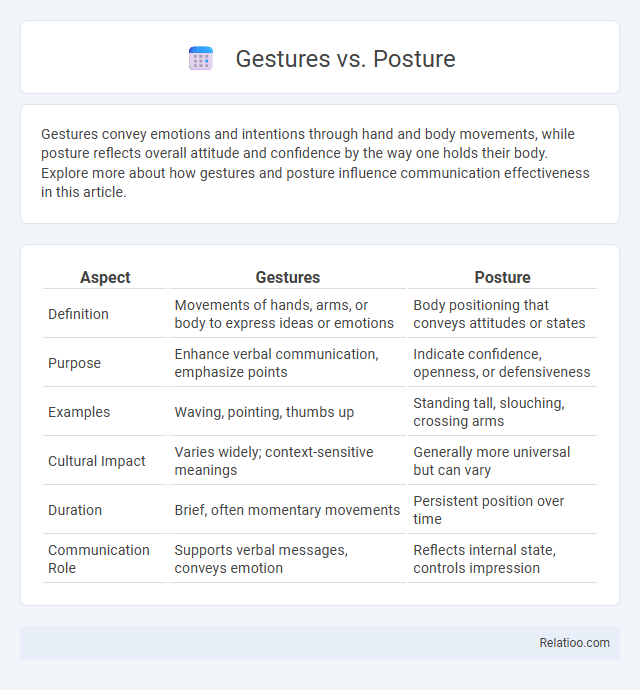Gestures convey emotions and intentions through hand and body movements, while posture reflects overall attitude and confidence by the way one holds their body. Explore more about how gestures and posture influence communication effectiveness in this article.
Table of Comparison
| Aspect | Gestures | Posture |
|---|---|---|
| Definition | Movements of hands, arms, or body to express ideas or emotions | Body positioning that conveys attitudes or states |
| Purpose | Enhance verbal communication, emphasize points | Indicate confidence, openness, or defensiveness |
| Examples | Waving, pointing, thumbs up | Standing tall, slouching, crossing arms |
| Cultural Impact | Varies widely; context-sensitive meanings | Generally more universal but can vary |
| Duration | Brief, often momentary movements | Persistent position over time |
| Communication Role | Supports verbal messages, conveys emotion | Reflects internal state, controls impression |
Understanding Gestures and Posture
Gestures are deliberate movements of the hands, arms, or body used to communicate specific messages or emotions, while posture refers to the way a person holds their body, reflecting attitudes or feelings often unconsciously. Understanding gestures involves recognizing their cultural context and intent, as they can enhance verbal communication or convey meaning independently. Posture provides insights into confidence, openness, or defensiveness, revealing underlying emotions beyond spoken words in both personal and professional interactions.
Key Differences Between Gestures and Posture
Gestures are deliberate movements of the hands, arms, or head used to communicate specific messages, while posture refers to the way a person holds their body, reflecting attitudes or emotions more subtly. Gestures typically convey explicit meanings and are often culturally specific, whereas posture provides broader context about a person's mood or confidence level without precise symbolic content. Nonverbal cues encompass both gestures and posture, along with facial expressions and proxemics, forming a comprehensive system for nonverbal communication.
The Role of Gestures in Communication
Gestures play a crucial role in communication by enhancing verbal messages through visual emphasis and emotional expression. Unlike posture, which conveys overall body orientation and attitude, gestures provide direct and dynamic signals that can clarify intent or indicate specific ideas. As a primary form of nonverbal cues, gestures facilitate understanding, reduce ambiguity, and support cultural and contextual meanings in interpersonal interactions.
How Posture Influences Perception
Posture significantly shapes how others perceive Your confidence, openness, and authority by conveying subconscious signals through body alignment. An upright, relaxed posture often projects competence and approachability, while slouched or closed positions may suggest insecurity or disinterest. Understanding the impact of posture as a nonverbal cue helps you manage impressions and enhance interpersonal communication effectively.
Cultural Variations in Gestures and Posture
Cultural variations significantly influence the interpretation and appropriateness of gestures and posture, where a gesture considered polite in one culture may be offensive in another. Posture reflects nonverbal cues that convey respect, authority, or submission differently across societies, impacting how Your communication is perceived globally. Understanding these cultural nuances in nonverbal cues enhances cross-cultural interactions and avoids misunderstandings.
The Psychological Impact of Body Language
Gestures, posture, and nonverbal cues collectively shape the psychological impact of body language by influencing perception, emotion, and communication effectiveness. Your open posture can convey confidence and approachability, while specific gestures often reinforce or contradict spoken messages, altering the receiver's emotional response and trust levels. Understanding these elements helps decode underlying intentions and emotional states, enhancing interpersonal connections and psychological insight.
Gestures vs Posture in Professional Settings
Gestures in professional settings are deliberate hand or arm movements used to emphasize points or convey confidence, while posture reflects the overall body alignment that communicates professionalism and attentiveness. Your body posture influences how others perceive your confidence and engagement, whereas gestures support verbal communication by adding clarity and emotional nuance. Understanding the distinction between gestures and posture enhances your nonverbal communication effectiveness during presentations, meetings, and networking.
Common Misinterpretations of Gestures and Posture
Gestures and posture are critical forms of nonverbal cues that often lead to common misinterpretations due to cultural differences and contextual ambiguity. Your crossed arms might be perceived as defensive or closed-off, while the same posture could simply indicate comfort or warmth in certain cultures. Misreading these signals can result in misunderstandings, making it essential to consider context and individual differences when interpreting gestures and posture.
Enhancing Communication Through Body Language Awareness
Understanding the distinctions between gestures, posture, and nonverbal cues is crucial for enhancing communication through body language awareness. Gestures involve deliberate hand movements that emphasize or convey specific messages, while posture reflects your overall body stance, signaling confidence or openness. Mastering these elements, along with subtle nonverbal cues such as facial expressions and eye contact, empowers you to communicate more effectively and build stronger interpersonal connections.
Practical Tips for Improving Gestures and Posture
Improving gestures involves practicing purposeful hand movements that complement speech and convey confidence, such as open palms and controlled motions. Enhancing posture requires maintaining an upright position with relaxed shoulders and a stable stance to project authority and approachability. Consistently integrating mindful gestures with positive posture strengthens overall nonverbal communication and fosters better interpersonal connections.

Infographic: Gestures vs Posture
 relatioo.com
relatioo.com